by Bruce Wells | Apr 5, 2024 | Petroleum Transportation
Pennsylvanians advance oil industry infrastructure and later help invent “QWERTY” typewriter keyboard.
As Northwestern Pennsylvania oil production skyrocketed following the Civil War, railroad oil tank cars fabricated by two brothers improved shipment volumes from oilfields to kerosene refineries. The tank car designed by James and Amos Densmore would not last long, but more success followed when Amos came up with an innovative keyboard arrangement for typewriters.
Flatbed railroad cars with two wooded oil tank cars became the latest advancement in oilfield infrastructure after the Densmore brothers patented their design on April 10, 1866.
The inventors from Meadville, Pennsylvania, had developed an “Improved Car for Transporting Petroleum” one year earlier in America’s booming oil regions. The first U.S. oil well had been drilled just seven years earlier along Oil Creek in Titusville.

The first functional railway oil tank car was invented and constructed in 1865 by James and Amos Densmore at the Miller Farm along Oil Creek, Titusville, Pennsylvania. Photo courtesy Drake Well Museum and Park.
Using an Atlantic & Great Western Railroad flatcar, the brothers secured two tanks in order to ship oil in bulk. The patent (no. 53,794) described and illustrated the railroad car’s design.
The nature of our invention consists in combining two large, light tanks of iron or wood or other material with the platform of a common railway flat freight-car, making them practically part of the car, so as they carry the desired substance in bulk instead of in barrels, casks, or other vessels or packages, as is now universally done on railway cars.

Development of railroad tank cars came when traditional designs, including the flatcar, hopper, and boxcar, proved inadequate for large amounts of oil — often shipped in 42-gallon barrels.
New designs were born out of necessity, as the fledgling oil industry demanded a better car for the movement of its product, according to American-Rails.com.
“Before the car was developed, railroads used a combination of boxcars, flatcars, and gondolas to haul everything from lumber and coal to crude oil, molasses, and water (by use of barrels),” noted Adam Burns in 2022. “One of the most prolific car types you will find moving within a freight train today is the tank car.”
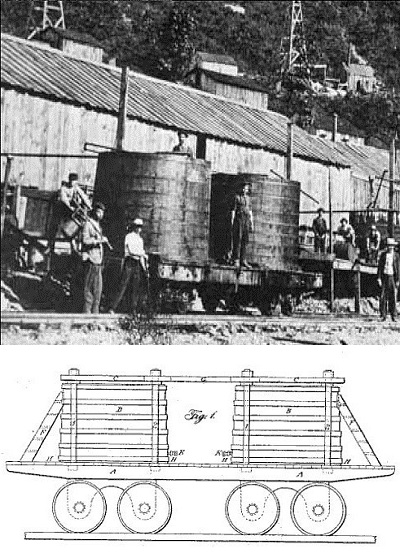
Prone to leaks and top heavy, Densmore tank cars provided a vital service, if only for a few years before single, horizontal tanks replaced them.
According to transportation historian John White Jr., the Densmore brothers’ oil tank design essentially consisted of a flat car with wooden vats attached. “The Central Pacific is known to have used such specialized cars to transport water, he noted in his 1995 book, The American Railroad Freight Car.
“However, prior to the discovery of oil by Colonel Edward (sic) Drake near Titusville, Pennsylvania, on August 27, 1859, the tank car was virtually non-existent,” added White, a former curator of Transportation at the Smithsonian Institution.
Dual Tank Design
The brothers further described the use of special bolts at the top and bottom of their tanks to act as braces and “to prevent any shock or jar to the tank from the swaying of the car while in motion.”

A Pennsylvania historical marker on U.S. 8 south of Titusville commemorates the Densmore brothers’ significant contribution to petroleum transportation technology. Dedicated in 2004, the marker notes:
The first functional railway oil tank car was invented and constructed in 1865 by James and Amos Densmore at nearby Miller Farm along Oil Creek. It consisted of two wooden tanks placed on a flat railway car; each tank held 40-45 barrels of oil. A successful test shipment was sent in September 1865 to New York City. By 1866, hundreds of tank cars were in use. The Densmore Tank Car revolutionized the bulk transportation of crude oil to market.
The benefit of such railroad cars to the early petroleum industry’s infrastructure was immense, especially as more Americans eagerly sought oil-refined kerosene for lamps.
Despite design limitations that would prove difficult to overcome, independent producers took advantage of the opportunity to transport large amounts of petroleum. Other transportation methods required teamsters taking barrels to barges on Oil Creek and the Allegheny River to get to kerosene refineries in Pittsburgh.
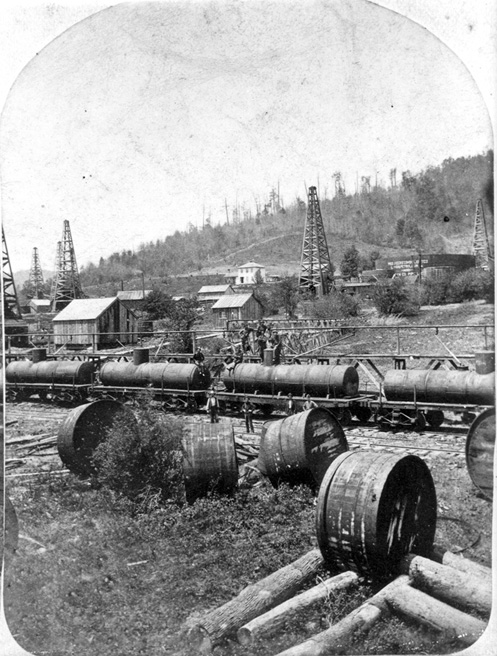
Riveted cylindrical iron tank cars replaced Densmore brothers’ wooden vat cars. Discarded Densmore tanks can be seen. Photo courtesy Drake Well Museum.
As larger refineries were constructed, it was found that it cost $170 less to ship 80 barrels of oil from Titusville to New York in a tank car instead of individual barrels. But the Densmore cars had flaws.
They were unstable, top heavy, prone to leaks, and limited in capacity by the eight-foot width of the flatcar. Within a year, oil haulers shifted from the Densmore vertical vats to larger, horizontal riveted iron cylindrical tanks, which also demonstrated greater structural integrity during derailments or collisions.

The same basic cylindrical design for transporting petroleum can be seen as modern railroads load products from corn syrup to chemicals — all in a versatile tank car that got its start in the Pennsylvania oil industry.
Oil Tanks to Typewriters
Although the Densmore brothers left the oil region by 1867 — their inventiveness was far from over. In 1875, Amos Densmore assisted Christopher Sholes to rearrange the “type writing machine” keyboard so that commonly used letters no longer collided and got stuck. The “QWERTY” arrangement vastly improved Shole’s original 1868 invention.

Amos Densmore helped invent one of the first practical typewriters.
Following his brother’s work with Sholes, inventor of the first practical typewriter, James Densmore’s oilfield financial success helped the brothers establish the Densmore Typewriter Company, which produced its first model in 1891. Few historians have made the oil patch to typewriter keyboard connection — including Densmore biographers.

“Biographies of the Densmores — and even their personal papers now residing at the Milwaukee Public Museum — all refer to their work on typewriters, but make no mention of their pioneering work in railroad tank car design,” notes the Pennsylvania Historical Commission.
_______________________
Recommended Reading: The American Railroad Freight Car (1995); Early Days of Oil: A Pictorial History of the Beginnings of the Industry in Pennsylvania (2000); Story of the Typewriter, 1873-1923 (2019); Myth, Legend, Reality: Edwin Laurentine Drake and the Early Oil Industry
(2000); Story of the Typewriter, 1873-1923 (2019); Myth, Legend, Reality: Edwin Laurentine Drake and the Early Oil Industry (2009). Your Amazon purchase benefits the American Oil & Gas Historical Society. As an Amazon Associate, AOGHS earns a commission from qualifying purchases.
(2009). Your Amazon purchase benefits the American Oil & Gas Historical Society. As an Amazon Associate, AOGHS earns a commission from qualifying purchases.
_______________________
The American Oil & Gas Historical Society (AOGHS) preserves U.S. petroleum history. Become an AOGHS annual supporting member and help maintain this energy education website and expand historical research. For more information, contact bawells@aoghs.org. © 2024 Bruce A. Wells. All rights reserved.
Citation Information – Article Title: “Densmore Oil Tank Cars.” Authors: B.A. Wells and K.L. Wells. Website Name: American Oil & Gas Historical Society. URL: https://aoghs.org/transportation/densmore-oil-tank-car. Last Updated: April 5, 2024. Original Published Date: April 7, 2013.
by Bruce Wells | Mar 15, 2024 | Petroleum Transportation
“No one anticipated any unusual problems as the Exxon Valdez left the Alyeska Pipeline Terminal at 9:12 p.m., Alaska Standard Time,” an account by the Alaska Oil Spill Commission would later report about the March 24, 1989, offshore disaster.
After nearly a dozen years of routine daily passages through Prince William Sound, Alaska, an oil tanker ran aground, rupturing the hull. Supertanker Exxon Valdez hit Bligh Reef and spilled more than 260,000 barrels of oil, affecting hundreds of miles of coastline. Some consider the spill amount used by Alaska’s Exxon Valdez Oil Spill Trustee Council as too conservative.

Field studies continue to examine the effects of the Exxon supertanker’s disastrous grounding on Bligh Reef in Alaska’s Prince William Sound in 1989. Photo courtesy Erik Hill, Anchorage Daily News.
A General Complacency
When the 987-foot tanker hit the reef shortly after midnight, “the system designed to carry two million barrels of North Slope oil to West Coast and Gulf Coast markets daily had worked perhaps too well,” according to the Alaska Oil Spill Commission’s initial report.
“At least partly because of the success of the Valdez tanker trade, a general complacency had come to permeate the operation and oversight of the entire system,” the commission noted. Complacency about giant oil tankers ended on March 24, 1989, when the Exxon Valdez ran aground on Bligh Reef.

“The vessel came to rest facing roughly southwest, perched across its middle on a pinnacle of Bligh Reef,” added the commission’s report. “Eight of 11 cargo tanks were punctured. Computations aboard the Exxon Valdez showed that 5.8 million gallons had gushed out of the tanker in the first three and a quarter hours.”

“Eight of 11 cargo tanks were punctured. Computations aboard the Exxon Valdez showed that 5.8 million gallons had gushed out of the tanker in the first three and a quarter hours.”
Tankers carrying North Slope crude oil had safely transited Prince William Sound more than 8,700 times during the previous 12 years. Improved shipbuilding technologies resulted in supersized vessels.
“Whereas tankers in the 1950s carried a crew of 40 to 42 to manage about 6.3 million gallons of oil…the Exxon Valdez carried a crew of 19 to transport 53 million gallons of oil,” the report explained.
Alaskan weather conditions — 33 degrees with a light rain — and the remote location added to the 1989 disaster, the report continues. With the captain not present, the third mate made a navigation error, according to another 1990 investigation by the National Transportation and Safety Board, Practices that relate to the Exxon Valdez.
“The third mate failed to properly maneuver the vessel, possibly due to fatigue or excessive workload,” the Safety Board concluded.

Containing Oil Spills
At the time, spill response capabilities to deal with the spreading oil will be found to be unexpectedly slow and woefully inadequate, according to the Oil Spill Commission.
“The worldwide capabilities of Exxon Corporation would mobilize huge quantities of equipment and personnel to respond to the spill — but not in the crucial first few hours and days when containment and cleanup efforts are at a premium,” the commission’s report explained.

At 987 feet long and 166 feet wide, the Exxon Valdez — delivered to Exxon in December 1986 — was the largest ship ever built on the West Coast.
The commission added that the U.S. Coast Guard, “would demonstrate its prowess at ship salvage, protecting crews and lightering operations, but prove utterly incapable of oil spill containment and response.”
Spill Cleanup Lessons
Exxon began a cleanup effort that included thousands of Exxon and contractor personnel, according to ExxonMobil. More than 11,000 Alaska residents and volunteers rushed to the coastline to assist.
“Because Prince William Sound contained many rocky coves where the oil collected, the decision was made to displace it with high-pressure hot water,” noted a 2001 study for the American Academy of Underwater Sciences.

“However, this also displaced and destroyed the microbial populations on the shoreline; many of these organisms (e.g. plankton) are the basis of the coastal marine food chain, and others (e.g. certain bacteria and fungi) are capable of facilitating the biodegradation of oil,” explained scientific diving expert Stephen Jewett, professor emeritus of environmental studies at the University of Alaska, Fairbanks.
“At the time, both scientific advice and public pressure was to clean everything, but since then, a much greater understanding of natural and facilitated remediation processes has developed, due somewhat in part to the opportunity presented for study by the Exxon Valdez spill.” Jewett added.
His academic paper, “Scuba techniques used to assess the effects of the Exxon Valdez oil spill,” brought insights to mitigating the impact of the Alaskan oil spill — which had expedited passage of the Oil Pollution Act of 1990.
According to ExxonMobil, the company spent $4.3 billion as a result of the accident, “including compensatory payments, cleanup payments, settlements and fines. The company voluntarily compensated more than 11,000 Alaskans and businesses within a year of the spill.”
A study conducted by the Alaska Oil Spill Commission resulted in the February 1990 report, “Details about the Accident.”
Experts have continued to review effects of the Exxon Valdez grounding on Bligh Reef; most have reported that although the ecosystem in Prince William Sound continues to recover, it is healthy.

In March 2014, a 70-page review by the National Oceanic and Atmospheric Administration (NOAA report), “Twenty-Five Years After the Exxon Valdez Oil Spill: NOAA’s Scientific Support, Monitoring, and Research,” examined the incident and NOAA’s involvement in the response, operational monitoring, and subsequent research.
Two decades before Alaska’s 1989 Exxon Valdez grounding, an oil spill from a Union Oil offshore platform six miles off the coast of Santa Barbara, California, led to the modern environmental movement — and establishment of the Environmental Protection Agency (EPA).
Learn more about the 1969 California offshore accident in Oil Seeps and Santa Barbara Spill.
_______________________
Recommended Reading: The Exxon Valdez Oil Spill, Perspectives on Modern World History (2011); Slick Policy: Environmental and Science Policy in the Aftermath of the Santa Barbara Oil Spill
(2011); Slick Policy: Environmental and Science Policy in the Aftermath of the Santa Barbara Oil Spill (2018); Amazing Pipeline Stories: How Building the Trans-Alaska Pipeline Transformed Life in America’s Last Frontier
(2018); Amazing Pipeline Stories: How Building the Trans-Alaska Pipeline Transformed Life in America’s Last Frontier (1997). Your Amazon purchase benefits the American Oil & Gas Historical Society. As an Amazon Associate, AOGHS earns a commission from qualifying purchases.
(1997). Your Amazon purchase benefits the American Oil & Gas Historical Society. As an Amazon Associate, AOGHS earns a commission from qualifying purchases.
_______________________
The American Oil & Gas Historical Society (AOGHS) preserves U.S. petroleum history. Become an AOGHS annual supporting member and help maintain this energy education website and expand historical research. For more information, contact bawells@aoghs.org. © 2024 Bruce A. Wells. All rights reserved.
Citation Information – Article Title: “Exxon Valdez Oil Spill.” Authors: B.A. Wells and K.L. Wells. Website Name: American Oil & Gas Historical Society. URL: https://aoghs.org/transportation/exxon-valdez-oil-spill. Last Updated: March 15, 2024. Original Published Date: March 24, 2009.
by Bruce Wells | Jan 2, 2024 | Petroleum Transportation
A Library of Congress photo tells many early automobile tales.
Picturing history, images in the Library of Congress digital collection offer rare insights into the early U.S. petroleum industry.
Details found in just one 1921 black-and-white photograph of a Washington, D.C., suburb capture a scene of petroleum products and transportation infrastructure two decades after the first U.S. auto show. Originally printed from an eight-inch by six-inch glass negative, the Library of Congress image features Takoma Park, Maryland, and its railroad station on the northeastern border of the District of Columbia.
(more…)
by Bruce Wells | Dec 21, 2023 | Petroleum Transportation
Famous New York World reporter of 1880s would take charge of Iron Clad Manufacturing Company.
She was one of the most famous journalists of her day as a reporter for the New York World. Widely known as the remarkable Nellie Bly, Elizabeth J. Cochran Seaman, investigated conditions at an infamous mental institution, made a trip around the world in less than 80 days — and manufactured the first practical 55-gallon oil drum.
The 1901 Pan-American Exposition in Buffalo, N.Y., promoted her Iron Clad Manufacturing Company as “owned exclusively by Nellie Bly – the only woman in the world personally managing industries of such magnitude.”
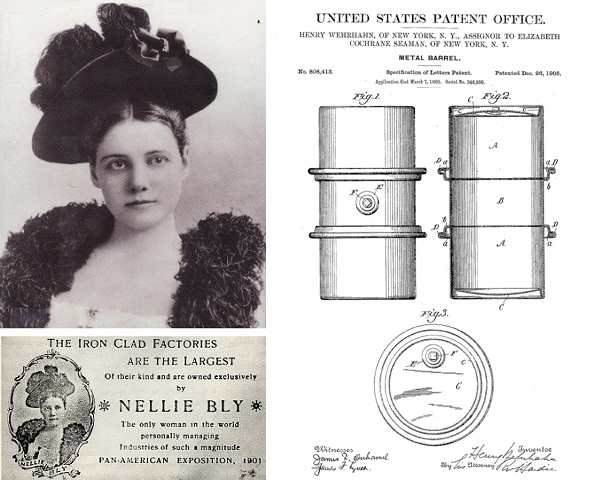
Recognizing the potential of an efficient metal barrel design, Nellie Bly acquired the 1905 patent rights from its inventor, Henry Wehrhahn, who worked at her Iron Clad Manufacturing Company.
(more…)
by Bruce Wells | Dec 5, 2023 | Petroleum Transportation
Practically since its opening day in 1979, the Iowa 80 Trucking Museum has hosted an annual Jamboree attended by thousands. The trucking museum in Walcott has more than 100 antique trucks on display, including an 1890 Standard Oil triple wagon; a 1903 Eldridge; 1910 Avery tractor/gasoline farm wagon; and a 1911 Walker Electric Model 43.
The museum’s collection began thanks to truck stop founder Bill Moon, who had a passion for trucks and truck history. Every summer, the museum at exit 284 on I -80 outside Walcott, Iowa, hosts a variety of events for truckers and other travelers, teachers, students — and transportation history buffs.
“Bill had a passion for collecting antique trucks and other trucking memorabilia,” notes the Iowa 80 Trucking Museum website. “We are pleased to be able to share this collection with the general public. Every truck has a story to tell and can provide a unique glimpse back in time. Many rare and one-of-a-kind trucks are on display.”
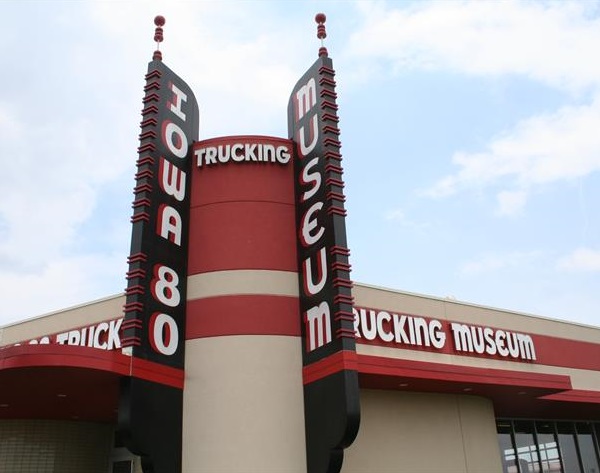
“If you are the least bit into cars you will find the museum interesting and well worth the stop,” notes a visitor from Legendary Collector Cars.”From what we could tell, it looks like this I-80 Exit at Walcott Iowa is about to become the over the road truckers Disneyland in a few years.”
The museum, which offers short films about trucking history, attracts all kinds of visitors, from those interested in antique trucks to those wanting to learn the history of modern, big rigs. Exhibit spaces, which expanded in March 2012, now offer a free app for iPhones and Androids with audio narratives. (more…)
by Bruce Wells | Nov 27, 2023 | Petroleum Transportation
Service stations gasoline pumps began in the 1880s as a device for dispensing kerosene at a grocery store.
Presaging the first gas pump, S.F. (Sylvanus Freelove) Bowser sold his newly invented kerosene pump to the owner of a grocery store in Fort Wayne, Indiana, on September 5, 1885. Less than two decades later, the first purposely built drive-in gasoline service station opened in Pittsburgh, Pennsylvania.
Bowser designed a simple device for reliably measuring and dispensing kerosene — a product in high demand as lamp fuel for half a century. His invention soon evolved into the metered gasoline pump.

Gas pumps with dials were followed by calibrated glass cylinders. Meter pumps using a small glass dome with a turbine inside replaced the measuring cylinder as pumps continued to evolve. Illustration courtesy Popular Science, September 1955.
Originally designed to safely dispense kerosene as well as “burning fluid, and the light combustible products of petroleum,” early S.F. Bowser pumps had marble valves with wooden plungers and upright faucets.

With the pump’s popular success at Jake Gumper’s grocery store, Bowser formed the S.F. Bowser & Company and patented his invention in late October 1887.
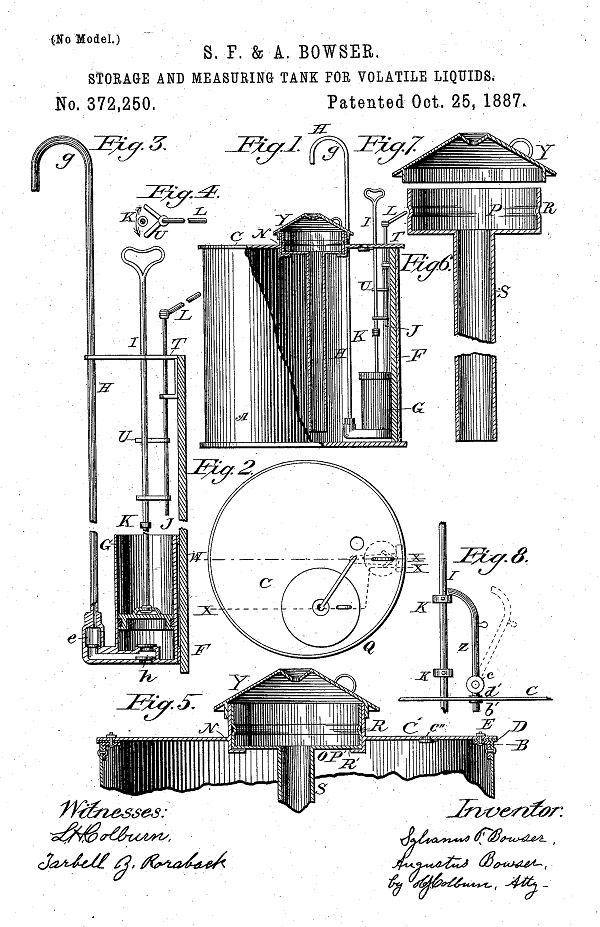
Bowser’s 1887 patent was a pump for “such liquids as kerosene-oil, burning-fluid, and the light combustible products of petroleum.”
As consumer demand for kerosene (and soon, gasoline) grew, Bowser’s innovative device and those that followed faced competition from other manufacturers of self-measuring pumps. In Wayne, Indiana, the Wayne Oil Tank & Pump Company designed and built 50 of a new model in 1892, the company’s first year of business (learn more in Wayne’s Self-Measuring Pump).

S.F. Bowser’s “Self-Measuring Gasoline Storage Pumps” became known as “filling stations.” An upper clamshell closed for security when unattended.
Despite the competition, in the early 1900s – as the automobile’s popularity grew – Bowser’s company became hugely successful. His grocery store pump consisted of a square metal tank with a wooden cabinet equipped with a suction pump operated by hand-stroked lever action.
Beginning in 1905, Bowser added a hose attachment for dispensing gasoline directly into the automobile fuel tank. The S. F. Bowser “Self-Measuring Gasoline Storage Pump” became known to motorists as a “filling station” as more design innovations followed.
The popular Bowser Model 102 “Chief Sentry” with its “clamshell” cover offered security when the pump was left unattended (see the 1920 Diamond Filling Station in Washington, D.C.).
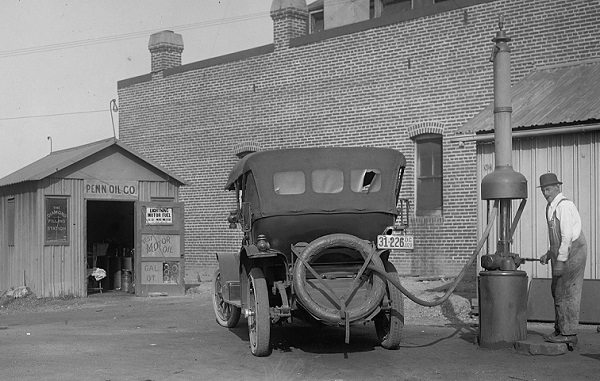
Manufactured in 1911, an S.F. Bowser Model 102 “Chief Sentry” pumped gas on North Capitol Street in Washington D.C., in 1920. The Penn Oil Company’s pump’s topmost globe, today prized by collectors, survived only as a bulb. Photo courtesy Library of Congress.
With the addition of competing businesses such as Wayne Pump Company and Tokheim Oil Tank & Pump Company, the city of Fort Wayne, Indiana, became the gas-pump manufacturing capital of the world.

Some enterprising manufacturing companies even came up with coin-operated gas pumps.
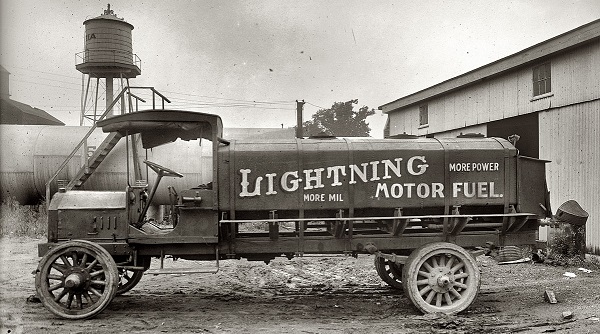
Penn Oil Company filling stations were the exclusive American distributor of Lightning Motor Fuel, a British product made up of “50 percent gasoline and 50 percent of chemicals, the nature of which is secret.” The secret ingredient was likely alcohol. Photo courtesy Library of Congress.
First Drive-In Service Station
Although Standard Oil will claim a Seattle, Washington, station of 1907, and others argue about one in St. Louis two years earlier, most agree that when “Good Gulf Gasoline” went on sale, Gulf Refining Company opened America’s first true drive-in service station.
Gulf Refining Company had been established in Pittsburgh, Pennsylvania, in 1901 by Andrew Mellon and other investors as an expansion of the J. W. Guffey Petroleum Company formed earlier the same year to exploit the Spindletop oilfield discovery in Texas. The company’s motoring milestone took place at the corner of Baum Boulevard and St. Clair Street in downtown Pittsburgh on December 1, 1913.
Unlike earlier simple curbside gasoline filling stations, an architect purposefully designed the pagoda-style brick facility that offered free air, water, crankcase service, and tire and tube installation.
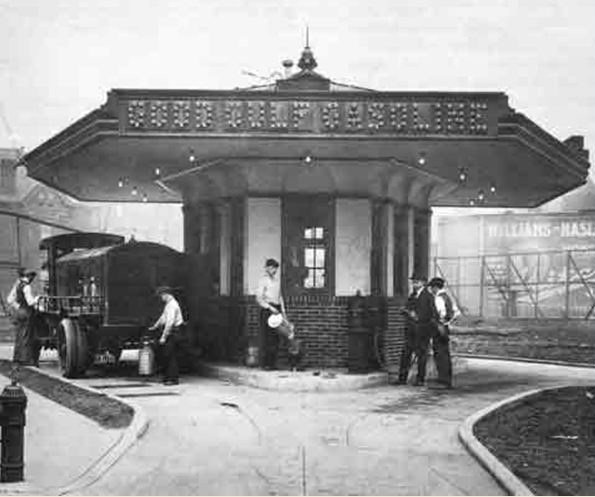
Gulf Refining Company’s decision in 1913 to open the first service station (above) along Baum Boulevard in Pittsburgh, Pennsylvania, was no accident. The roadway had become known as “automobile row'” because of its high number of dealerships. Photo courtesy Gulf Oil Historical Society.
“This distinction has been claimed for other stations in Los Angeles, Dallas, St. Louis and elsewhere,” noted a Gulf corporate historian. “The evidence indicates that these were simply sidewalk pumps and that the honor of the first drive-in is that of Gulf and Pittsburgh.”
The Gulf station included a manager and four attendants standing by. The original service station’s brightly lighted marquee provided shelter from bad weather for motorists. A photo of the station, designed by architect J.H. Giesey, may or may not have been taken on opening day, according to the Gulf Oil Historical Society.
“At this site in Dec. 1913, Gulf Refining Co. opened the first drive-in facility designed and built to provide gasoline, oils, and lubricants to the motoring public,” noted a Pennsylvania historical marker dedicated on July 11, 2000.
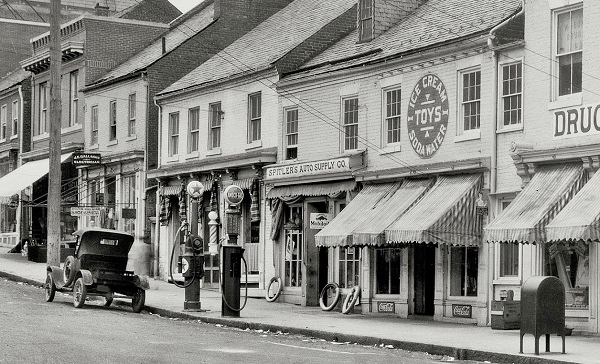
Spitlers Auto Supply Company, 205 Commerce Street, Fredericksburg, Virginia, closed in 1931. It was an example of curbside pumps used before Gulf Refining Company established covered, drive-through stations.
The drive-in station sold 30 gallons of gasoline at 27 cents per gallon on its first day, according to the Pennsylvania Historical and Museum Commission.
“Prior to the construction of the first Gulf station in Pittsburgh and the countless filling stations that followed throughout the United States, automobile drivers pulled into almost any old general or hardware store, or even blacksmith shops in order to fill up their tanks,” the historical commission noted at ExplorePAhistory.com.
The decision to open the first station along Baum Boulevard in Pittsburgh was no accident. When the station was opened, Baum Boulevard had become known as “automobile row” because of the high number of dealerships that were located along the thoroughfare.
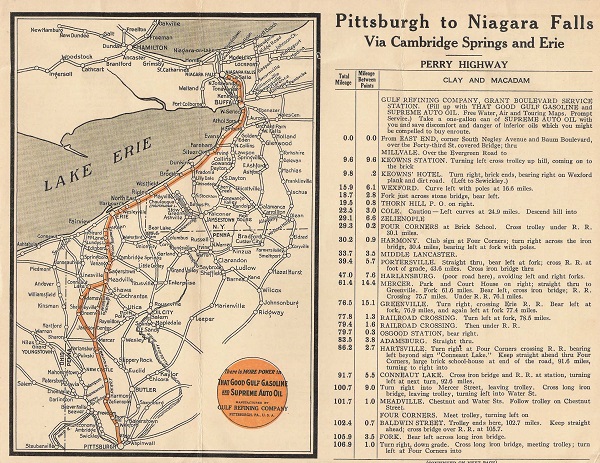
Until about 1925, Gulf Refining Company was the only oil company to issue maps. Gulf was formed in 1901 by members of the Mellon family of Pittsburgh. Map image courtesy Harold Cramer.
“Gulf executives must have figured that there was no better way to get the public hooked on using filling stations than if they could pull right in and gas up their new car after having just driven it off the lot,” noted a commission historian.
In addition to gas, the Gulf station also offered free air and water — and sold the first commercial road maps in the United States. “The first generally distributed oil company road maps are usually credited to Gulf,” said Harold Cramer in his “Early Gulf Road Maps of Pennsylvania.”
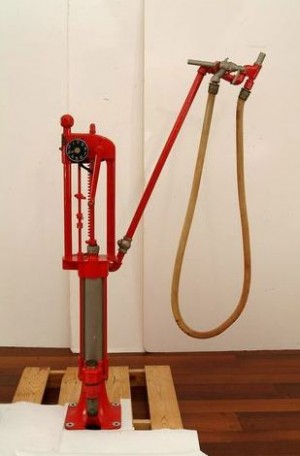
This 1916 Bowser gasoline pump operated by a hand crank and “clock face” dial. Photo from the Smithsonian Collection.
“The early years of oil company maps, circa 1915 to 1925, are dominated by Gulf as few other oil companies issued maps, and until about 1925 Gulf was the only oil company to issue maps annually,” Cramer explained. That would change.
Founded in 1996, the Road Map Collectors Association (RMCA) preserves the history of road maps to educate the public about America’s automobile age, also documented and exhibited by the Smithsonian Institution (see America on the Move).
While the Gulf station in Pittsburgh could be considered the first “modern” service station, kerosene and gasoline “filling stations” helped pave the way.
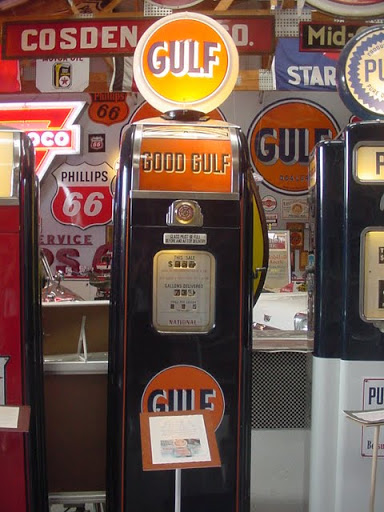
Collectors value station memorabilia, including this pump and globe exhibited at the Northwoods Petroleum Museum outside Three Lakes, Wisconsin, established in 2006.
“At the turn of the century, gasoline was sold in open containers at pharmacies, blacksmith shops, hardware stores and other retailers looking to make a few extra dollars of profit,” noted Kurt Ernst in a 2013 article.
“In 1905, a Shell subsidiary opened a filling station in St. Louis, Missouri, but it required attendants to fill a five gallon can behind the store, then haul this to the customer’s vehicle for dispensing…A similar filling station was constructed by Socal gasoline in Seattle, Washington, opening in 1907,” Ernst explained in his article “The Modern Gas Station celebrates its 100th Birthday.”
One-hundred years after the Gulf Refining Company station opened, America’s 152,995 operating gas stations included 123,289 convenience stores, according to Ernst. On average, each location sold about 4,000 gallons of fuel per day, “quite a jump from the 30 gallons sold at the Gulf station in Pittsburgh on December 1, 1913.”

Photographs of early service stations remain an important part of preserving U.S. transportation history (also true for architecture, pump technologies, advertising methods, and more). The American Oil & Gas Historical Society’s Dome Gas Station at Takoma Park offers insights revealed in just one 1921 black-and-white photograph of a station in a Washington, D.C., suburb.
The Library of Congress maintains a large collection of service station images, as do other libraries and organizations listed with it in AOGHS photo resources.
_______________________
Recommended Reading: Pump and Circumstance: Glory Days of the Gas Station (1993); Fill’er Up!: The Great American Gas Station
(1993); Fill’er Up!: The Great American Gas Station (2013); The American Highway: The History and Culture of Roads in the United States
(2013); The American Highway: The History and Culture of Roads in the United States (2000). Your Amazon purchase benefits the American Oil & Gas Historical Society. As an Amazon Associate, AOGHS earns a commission from qualifying purchases.
(2000). Your Amazon purchase benefits the American Oil & Gas Historical Society. As an Amazon Associate, AOGHS earns a commission from qualifying purchases.
_______________________
The American Oil & Gas Historical Society (AOGHS) preserves U.S. petroleum history. Become an AOGHS annual supporting member and help maintain this energy education website and expand historical research. For more information, contact bawells@aoghs.org. Copyright © 2023 Bruce A. Wells. All rights reserved.
Citation Information: Article Title: “First Gas Pump and Service Station.” Authors: B.A. Wells and K.L. Wells. Website Name: American Oil & Gas Historical Society. URL: https://aoghs.org/transportation/first-gas-pump-and-service-stations. Last Updated: September 3, 2023. Original Published Date: March 14, 2013.




(2000); Story of the Typewriter, 1873-1923 (2019); Myth, Legend, Reality: Edwin Laurentine Drake and the Early Oil Industry
(2009). Your Amazon purchase benefits the American Oil & Gas Historical Society. As an Amazon Associate, AOGHS earns a commission from qualifying purchases.

















